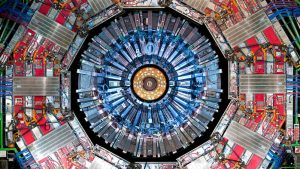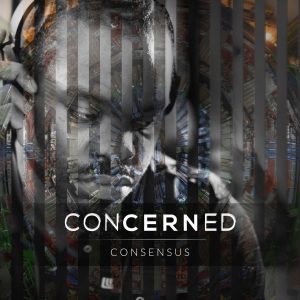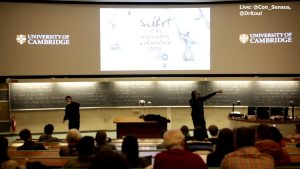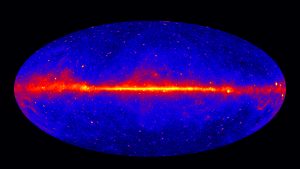The quest to encourage the public to engage with science has perpetually troubled science communicators. It is an issue that is especially pressing now when the internet offers an ever-increasing array of news and opinion. Projects such as the Large Hadron Collider (LHC) are experimenting with the very building blocks of matter, the web of complex unfamiliar names can leave the layman baffled.

The public seems to have an underlying misunderstanding of the role the LHC plays in pushing the boundaries of physics. By directing charged particles around a 27 KM ring of superconducting magnets and colliding them at near-relativistic speeds researchers at the LHC aim to recreate the conditions found in the early Universe. A time at which it was much denser and hotter than it is today. It is hoped that by doing this physics will glimpse conditions under which the four-fundamental forces of nature were once united.
Without doubt the project’s crowning achievement was the indirect observation of the Higgs Boson, a particle long-theorised to be the product of the Higgs field. The field responsible for providing particles with mass.
But how do you communicate this to people with no physics background? Perhaps by integrating it with popular culture and art. In 2015 British rapper Consensus was involved ‘art@CMS‘, a remarkable project aimed at helping the public engage with the work conducted at the LHC and particle physics in general.
The result was the rap album ConCERNed.

Consensus is a London-based rapper heavily influenced by the underground rap and grime scene of 2003-2008. His debut EP Highly Dubstepive was released in 2012. In addition to this, he studied Aeronautic engineering, philosophy of science and physics in University.
We spoke to Consensus to discuss his personal experience engaging with science, how the album came about and the workshops for children that have sprung-up from it.
Probeta Mag: What were your experiences with science before beginning the project?
Consensus: In school, I was really into science, but I wasn’t focused in class. I was interested in the theory, but the way school taught was too dry. «You need to know this and that for the exam.»
By the time I came to university, I was tired of physics, but I had to do it as I did aeronautic engineering. In my third year, I chose a philosophy of science module, which answered questions for me like what science is and where does theory come from. When I think of science now, it’s through that lens.
I want to question the boundaries with a philosophical background. It was the guys like Faraday, who provided the building blocks of science that really interested me. I go through a handful of them in the ‘May Concern’ track on the album [ConCERNed].
What were the origins of ConCERNed?
Dr Koul, who features on the Method to the Madness track, he’s based in Switzerland and was working in a school doing an art and theory of knowledge project with art@CMS. He was working with a teacher called Stephen Priest. Through them, I was introduced to the concept of CERN in general. I wasn’t really aware of it before.

Dr Koul came to my house and asked me if I was interested in doing a track about physics. I’d done a couple of educational tracks before a track about sustainable energy called the Wind and a track about how the monetary system works.
Koul told me that Priest’s company was willing to fund me. They’d spoken to Michael Hoch [head of art@CMS at CERN] who said now is the perfect time to come over here [to the LHC]. So, I went over and met everybody on a 2 or 3-day tour.
From the visit, it became clear that I had way too much information for just one track. The track turned into an EP and then into a short album. It all moved very quickly.
Did you know much about particle physics before starting the project?
No. I had an engineering background, but the whole particle physics thing was completely new to me. I knew about electromagnetism and some nuclear physics, but the deeper stuff like the Higgs boson… no.
The melding of rap and particle physics is a pretty unique idea isn’t it?
I like to think so. That’s the point of music and art, to find something that hasn’t been done, but that will resonate with people. I like to do research and put that into rap. To get people to think «Wow that guy can really rap about anything.”
The video for Method to the Madness was filmed at the LHC. You and Dr Koul looked like you were having a fantastic time.
We filmed it about a year before it came out. It was great fun, but it was an intense shoot. Michael Hoch walked us around. He’s an artist as well as a scientist, so he had a good creative vision of where to shoot and what would be good angles to film from. The shot with us talking at a podium, that’s the actual podium where they announced the discovery of the Higgs Boson.
What happened after your tour of the LHC?
I was given my own scientist through art@CMS to talk to via E-mail. I tried to ask questions about the maths and the concepts I’d been introduced to. I didn’t just want to say stuff and make it rhyme. I wanted to understand what I was writing about.
It was hard work just to make it accessible. I wanted non-scientists to listen to it and get something out of it. Because of that, some of the tracks took months to write. The whole two and half years I was working on it, I just wanted to finish.
The way you introduced concepts like antimatter and matter colliding and exploding via metaphor was really striking to me.
Some of the metaphors, like the track Antimatter, came easily. When I was growing up in Lewisham there were two gangs @Shower gang’ and ‘Anti-Shower’ gang. That’s what I was thinking of writing that track, their rivalry.
The track Standard Model, I compared the standard model of particle physics to beauty-standards in society. The demographic I was looking to speak to there was fourteen-year-old girls. A demographic I’m very distanced from. So, it took a lot of work and research to relate. The track took about five or six months to write. In the workshops I do, the kids really love that one. It sounds the most commercial, but what it is saying is so far removed from that.

There’s a lot of pseudoscientific ideas surrounding the LHC, did you encounter any of that?
Yeah, especially in the underground hip-hop community here in London. You have intellectuals who know that they aren’t blowing up the world and then you have other people who think they’re doing crazy stuff.
Knowing I was on the ground filming in the LHC they’d ask me «what do they do?» and «what did you see?»
There’s not much room for them to continue with the rhetoric of «oh they’re doing crazy stuff» when I say what I saw there. That’s part of the reason I wanted to do the project, so I could make personal observations.
What I said to a lot of the scientists I met, is that you have to meet the general public on their level. Otherwise, you’re just ostracizing them. If people aren’t walked through what is going on at the LHC, they’re just going to make up their own minds. It’s understandable. If you can’t observe something yourself and you can’t explain it, you find the explanations that fit the best. The best-told stories. That’s where conspiracy theories come from. That’s why I don’t get upset when people say crazy things.
What are you working on now?
I’ve just released a seven-track EP called Total Recon, which I was writing at the same time as ConCERNed. I’m doing PR for that. I’ve just done a workshop in Canada at the Ontario Science Centre with a handful of different institutes, called the Origin Project. We did workshops with kids and measured their engagement with science before and after the sessions. I’ll be touring the states with Don Lincoln who does a lot of science engagement work with the public. We’re going to Fermilab in Chicago, Florida and New York giving a series of workshops and lectures based on the ConCERNed album.
I’m also working on a book for schools using the workshops as case studies. The idea is to get kids more interested in science without me having to be there. My music and visuals would go together with the activities in the book.
Would you revisit science as a topic for an album in the future?
I would, but it was hard work and I don’t just want to be thought of as the science rapper. The problem is, science just moves so fast. I want something that will last and stand the test of time.
I was thinking of a rap project on the law. Maybe a tech project, as I work in the Tech space and I want to get people up to speed on what is going on there.
Part of the issue with tackling science subjects is these aren’t ordinary projects. They take a lot more work and research. It’s more than just working on beats and lyrics.
«I compared the standard model of particle physics to beauty-standards in society»
What do you think the future holds for art/science collaborations?
I think it’s positive. When I started this project, no one knew what this would be or what it would look like.
I tried to make ConCERNed a music album above all else. People tried to categorise it as «that science thing.» That’s annoying. Why can’t it be both? It’s science and art. It’s music first, with a science element. That’s why it’s engaged kids.
It’s commercial sounding. It’s not cheesy. Kids see right through that stuff. They’re smarter than we give them credit for.
From the workshops, there have been loads of kids who have created science-based-raps. There were some Austrian kids who created a rap comparing a relationship that falls apart to Feynman diagrams. You know, the particles come in, interact and then separate, changed. They performed it for the Austrian ambassador. Now there are lots of different parties looking at this kind of thing. I just kind of fit in now.
That’s cool.
#Cultural Data
What is the universe made of? How did it start? Physicists at CERN (European Organization for Nuclear Research), are seeking answers, using some of the world’s most powerful particle accelerators.
Physicists use the world’s largest and most complex scientific instruments to study the basic constituents of matter, the fundamental particles. The particles are made to collide together at close to the speed of light. The process gives the physicists clues about how the particles interact, and provides insights into the fundamental laws of nature.
The instruments used at CERN are purpose-built particle accelerators and detectors. Accelerators boost beams of particles to high energies before the beams are made to collide with each other or with stationary targets. Detectors observe and record the results of these collisions.
The biggest draw card at CERN is the Large Hadron Collider (LHC), the world’s largest subatomic particle accelerator. The LHC is a 27-kilometre ring of super powerful magnets within which two high-energy particle beams travel at the speed of light before they are made to smash into each other like a head-on car crash. The LHC is poised to take our understanding of what’s possible in this universe to unprecedented heights.
Source: CERN
Cover image: An event display from the LHC’s first ever proton-lead collisions, measured by the ALICE detector (Credit: CERN)
Article edited by: Sara Isabel García
